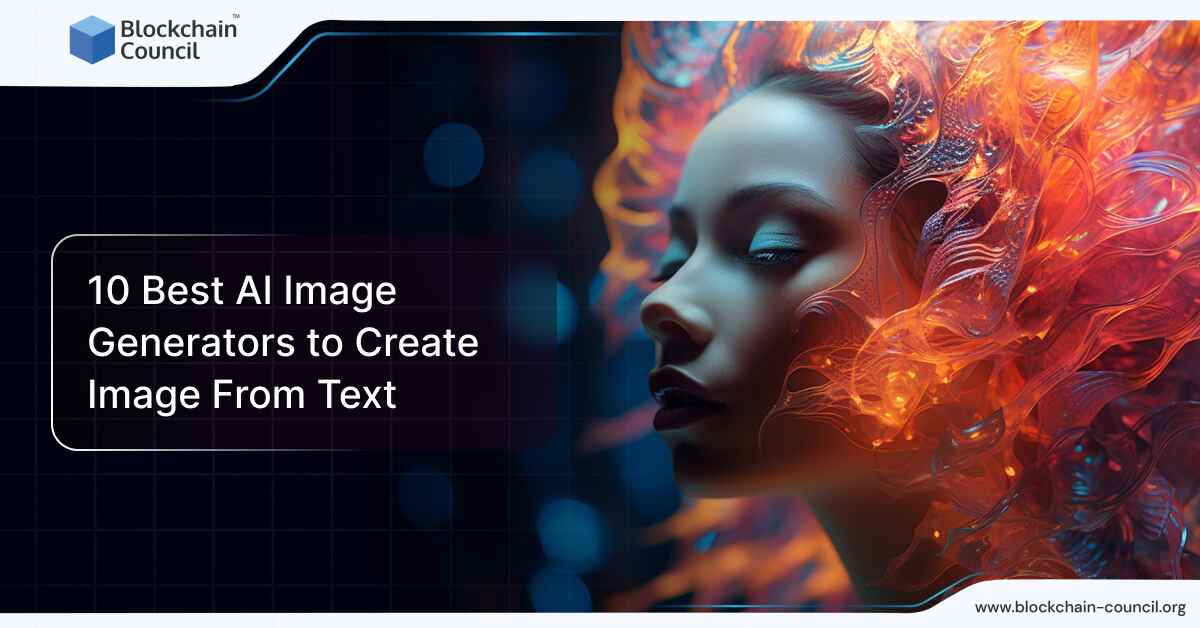
- Blockchain Council
- September 13, 2024
Summary
- AI art generators use machine learning to create images from text prompts, transforming the creative landscape.
- Commercial success in AI-generated art, with pieces selling for substantial amounts, has highlighted its financial potential.
- This article explores the top 10 AI art generators, analyzing their features, usability, and impact.
- AI art generators interpret text prompts into visual pieces using vast image-text databases.
- Evolution of AI art, from AARON in the 1970s to advanced systems like Midjourney and DALL-E 2.
- Two primary types of models used: Diffusion models and Generative Adversarial Networks (GANs).
- AI art generators have broad applications in digital marketing, game design, and entertainment.
- They offer flexibility, catering to various needs and artistic preferences.
- Adobe Firefly exemplifies AI art generator versatility, producing different styles from text input.
- Top AI art generators include Midjourney, Leonardo AI, Pixlr, NightCafe AI, Stability AI, DALL-E 2, StarryAI, Jasper Art, Neural Love, and Soulgen.
- Features to consider when choosing an AI art generator: customization options, image quality, and ease of use.
- Considerations for specific needs include genre and style preferences and licensing for commercial use.
- User reviews and community engagement can provide valuable insights into AI art generator performance and limitations.
AI art generators are transforming the creative landscape, enabling anyone to create stunning visuals from text. These tools have surged in popularity, becoming integral in art and design. From their inception over four decades ago to today’s advanced systems using billions of image-text pairs, AI art generators have evolved dramatically.
One notable aspect is the commercial success of AI-generated art, with sales reaching astonishing figures, such as a piece selling for $432,000 at Christie’s. The rise of AI-generated NFTs has further highlighted the financial potential of AI in art, with some NFTs selling for millions.
In this article, we will explore the top 10 AI art generators, examining their features, usability, and impact on the art world. By understanding the capabilities, unique features, and potential applications of these tools, readers can discover new ways to unleash their creativity. Whether you’re an artist looking to experiment with digital mediums, a marketer seeking innovative visual content, or simply curious about the intersection of technology and art, this guide will provide valuable insights into the exciting world of AI-generated art.
What are AI Art Generators?
AI art generators are technologies that use machine learning models to create images based on text prompts. These prompts can be as simple or as detailed as desired, and the AI works to interpret the request into a visual piece. This process relies on vast databases of image-text pairs, enabling the AI to learn and differentiate between various subjects, styles, and elements.
Evolution of AI in Art: A Timeline
- 1970s: Harold Cohen develops AARON, the first AI art generator.
- 2021: Launch of AI Art House, the first AI art NFT series.
- 2022: Stable Diffusion goes viral, showcasing the capabilities of text-to-image generators.
- 2023: AI-generated art continues to grow in popularity, with platforms like Midjourney and DALL-E 2 leading the way.
How AI Art Generators Work: From Text to Image
The operation of AI art generators begins with the user inputting a text prompt. The AI then analyzes this prompt, drawing from its training on countless image-text pairs. This training allows the AI to understand the request and generate an image that corresponds to the prompt. There are primarily two types of models used in this process:
- Diffusion models: These models start with a random noise pattern and gradually refine it into an image that matches the prompt. They are known for producing high-quality and creative outputs.
- Generative Adversarial Networks (GANs): GANs consist of two parts: a generator that creates images and a discriminator that evaluates them. This process iterates until the generator produces an image that the discriminator cannot distinguish from real images.
Also Read: Deep Learning vs Machine Learning vs Artificial Intelligence: A Beginner’s Guide
The Significance of AI Art in Today’s Creative Landscape
AI art is making a significant impact on the creative world by providing tools that can generate compelling visuals in seconds. This has implications for various fields, including digital marketing, game design, and entertainment, where visual content is key. AI art generators are not just about creating art; they’re about opening up new avenues for creativity, experimentation, and expression. They enable creators to explore new styles, ideas, and concepts quickly and efficiently, often leading to unexpected and innovative outcomes.
By offering a wide range of possibilities from realistic images to abstract concepts, AI art generators cater to a diverse set of needs and preferences. Whether it’s generating visuals for social media, creating concept art for projects, or simply exploring artistic expressions, these tools provide a flexible and powerful means to bring imagination to life.
In the context of Adobe Firefly, for example, users can type in anything they imagine and see it come to life in various styles, from pop art to watercolor paintings. This tool highlights the versatility of AI art generators in creating a wide range of images, catering to different artistic preferences and needs. It underscores the capacity of AI to aid in creative processes, regardless of the user’s skill level.
10 Best AI Art Generators to Create Image From Text
Creating art from text has never been easier, thanks to AI art generators. These tools allow you to bring your imaginative concepts to life with just a few keystrokes. Here are the top picks for AI art generators that stand out for their unique features and capabilities.
Midjourney
- Overview: Midjourney, a notable AI art generator, impresses with its advanced versions, offering enhanced text rendition and a more literal interpretation of prompts. Available exclusively on Discord, it generates images using the /imagine command, providing users with four variations to choose from. Midjourney is recognized for its rapid prototyping capabilities, making it a favorite among artists and advertisers for generating original content swiftly.
- Standout Features: Continuous updates enhance its algorithm for more detailed and stylized images. Midjourney’s version 6, released in December 2023, was developed over nine months, indicating a commitment to improving image quality and text interpretation.
Leonardo AI
- Overview: Leonardo AI emerges as a formidable competitor in the AI art generation domain, akin to established names like Midjourney and Stable Diffusion. It distinguishes itself through an intuitive interface that simplifies the art creation process for users at all skill levels. Users can select from various pre-trained models to generate images directly from text prompts, adjusting parameters to refine outcomes.
- Standout Features: Leonardo AI is celebrated for its user-friendly platform that facilitates easy access to a multitude of AI-driven image models. This not only caters to non-technical users by saving time but also circumvents the need for expensive hardware. The tool’s Discord community, boasting over 1 million users, offers a space for creators to share, get feedback, and draw inspiration from a wide array of generated artworks.
Pixlr
- Overview: Pixlr introduces a dynamic AI image generator as part of its comprehensive suite of online photo editing and design tools. This platform is designed to be intuitive and user-friendly, making it accessible for both beginners and experienced creators. Pixlr’s AI tools enable users to effortlessly transform text into vibrant images, offering a seamless blend of creativity and technology.
- Standout Features: Pixlr stands out for its AI Generative Fill feature, which allows users to edit and enhance images with a touch of AI magic. By selecting areas of an image, users can replace them with new content generated from text prompts, making it possible to add or remove elements with ease. This innovative tool simplifies complex editing tasks, revolutionizing how images are manipulated and improved.
NightCafe AI Art Generator
- Overview: NightCafe AI stands out in the AI art generation arena with its dynamic conversion of text prompts into images and its user-friendly interface. It’s accessible via web and mobile devices, offering a seamless user experience across platforms.
- Standout Features: NightCafe utilizes advanced machine learning algorithms like VQGAN+CLIP and neural-style transfer, providing users with a variety of styles for their artwork. The platform encourages community engagement, where users can share their AI-generated artwork, participate in contests, and engage with other creators. It supports multiple creation methods, including text-to-image and neural-style transfer, and offers unique features like bulk creation and download, custom seeds, and a vibrant community.
Stability AI
- Overview: Stability AI has emerged as a key player in the AI art generation field, though specific details about its offerings were not explored in this session. Typically, platforms like Stability AI leverage cutting-edge technologies to transform textual descriptions into detailed images, utilizing generative adversarial networks (GANs) or diffusion models. These technologies enable the creation of highly detailed and diverse artworks, ranging from photorealistic images to abstract art.
- Standout Features: Stability AI, known for its development of Stable Diffusion, allows for high-quality image outputs and a wide range of creative possibilities. It’s designed to cater to both novice users and professionals, providing tools that can upscale images, refine details, and offer a wide array of artistic styles.
Also Read: Top 10 Machine Learning Projects In 2024
DALL-E 2
- Overview: DALL-E 2 is a revolutionary AI art generator developed by OpenAI. It stands out for its ability to produce highly detailed and complex images from textual descriptions. This capability extends to editing existing images based on new prompts, demonstrating an advanced understanding of textures, shadows, and styles. The tool’s versatility is underpinned by its training on a vast dataset of image-text pairs, enabling it to render visuals that closely match the user’s imagination
- Standout Features: It’s notable for its ability to produce highly creative and detailed images based on user prompts. The integration with ChatGPT in its latest version, DALL-E 3, enhances its capabilities, making it even more powerful in generating accurate and imaginative visuals.
StarryAI
- Overview: StarryAI is an innovative app that turns text into mesmerizing works of art. It’s available on both iOS and Android platforms, offering a user-friendly interface and a variety of customization options. Users can generate up to 5 AI artworks daily without watermarks and retain full ownership of their creations.
- Standout Features: StarryAI stands out with its Orion and Argo engines, which offer unique capabilities in art styles, allowing users to choose between hand-painted looks and photorealism. The platform is accessible via mobile and web, making it easy to use anywhere. Additionally, users can experiment with different AI models and styles, and even have the option to turn their art into NFTs.
Jasper Art
- Overview: Jasper Art is another AI-powered art generator that enables users to create high-quality images from text descriptions. It’s designed to cater to a wide range of creative needs, from professional design work to personal projects.
- Standout Features: Features typically include a vast selection of styles and the ability to finely tune the output to match specific artistic visions. Jasper Art is celebrated for its ease of use and the quality of the images it can produce, making it a favorite among content creators and marketers looking for quick and impactful visual content.
Neural Love
- Overview: Neural Love offers a suite of AI-powered tools for various creative needs, including AI art generation, video enhancement, and photo restoration. Its AI art generator is capable of turning text prompts into a range of styles, from photorealistic images to anime and fantasy paintings. This platform is celebrated for its intuitive interface and the high quality of its creative output.
- Standout Features: Neural Love stands out with its versatile art generation capabilities, effortlessly transforming simple text prompts into a wide range of artistic styles. It takes media enhancement to the next level, improving the quality of images, videos, and audio through advanced AI algorithms. The user-friendly web interface ensures accessibility for all, eliminating the need for technical expertise or installations. What truly sets Neural Love apart is its custom AI model training option, enabling users to tailor AI for their specific projects.
Soulgen
- Overview: Soulgen is another popular AI art generator that specializes in creating both anime-style artwork and photorealistic portraits from text prompts. It leverages descriptive text to generate images that closely match the user’s vision, offering tools for image editing and outpainting to extend beyond original creations.
- Standout Features: Soulgen’s standout features include its ability to generate diverse and detailed images, offering options for anime and realistic styles. It also provides image editing tools and an outpainting feature for adding elements to existing images. Additionally, the platform encourages experimentation through interactive prompts, making it accessible for users to bring their creative ideas to life with ease.
Also Read: Top 10 Must-Have Machine Learning Skills
How to Choose the Right AI Art Generator?
When choosing an AI art generator, it’s essential to consider a range of factors to ensure the tool meets your creative needs and preferences. Here’s a guide on how to select the right AI art generator, drawing insights from various sources to help you make an informed decision:
Key Features to Look For
- Customization Options: The ability to tweak and customize your creations is crucial. Look for features like style options, resolution enhancements, and editing tools. Some generators offer unique functions like stylizing images to improve artistic quality or expanding on original images with zoom-out tools.
- Image Quality: The clarity and quality of generated images are vital. High-resolution outputs are especially important if you plan to use the images professionally or print them.
- Ease of Use: A user-friendly interface is key, especially for beginners. Generators should offer a straightforward process for creating art, from inputting text prompts to finalizing the artwork.
Considerations for Specific Needs
- Genre and Style: Your choice might depend on the specific art styles you’re interested in, such as realistic sketches, anime-style avatars, or abstract art. Some tools are more specialized, catering to specific genres or even allowing image generation from emojis for scenery.
- Licensing: If you intend to use the generated images for commercial purposes, ensure the tool provides royalty-free commercial use options. This is crucial for business owners, marketing teams, and content creators who need to use the images without legal concerns.
Tips for Evaluating User Reviews and Community Feedback
- Community Engagement: Platforms that foster a community, offer collaboration features, or provide access to art challenges can enhance your creative process. User reviews often highlight the value of community engagement and support.
- Performance and Limitations: User feedback can give insights into the tool’s performance, such as speed of generation, and any limitations, like difficulties in generating realistic images of specific body parts. This information can help you manage your expectations and choose a tool that aligns with your needs.
- Learning Curve: Especially for tools that offer deep customization and complex features, user reviews can shed light on the learning curve involved. While some tools are intuitive enough for beginners, others may require some time to master.
Conclusion
AI art generators represent a significant leap forward in the democratization of creativity, allowing individuals to create stunning visuals with simple text prompts. With these 10 AI art generators, you can explore a new realm of creativity, turning your words into beautiful visual masterpieces. These technologies have not only democratized art creation but also opened new avenues for exploration in the creative industries. As these tools continue to evolve, they promise to further blur the lines between human and machine-generated art, offering limitless possibilities for exploration and expression in the digital age.
Frequently Asked Questions
What is an AI Art Generator?
- AI art generators are tools that use artificial intelligence to create images based on text descriptions.
- They leverage machine learning models to interpret prompts and generate visuals that match the input.
How do AI Art Generators Work?
- These generators use complex algorithms, including neural networks and generative adversarial networks (GANs), to process text prompts and produce images.
- They draw from vast datasets to learn and mimic various artistic styles.
Can AI Art Generators Create Original Artwork?
- Yes, AI art generators can produce original artwork that is unique and not directly copied from existing images.
- However, the creativity and originality of the output can depend on the specificity and novelty of the text prompt.
Are AI-Generated Images Copyrighted?
- The copyright status of AI-generated images can be complex and varies by jurisdiction.
- Generally, images created by AI without direct human authorship fall into a legal gray area, and rights may depend on the tool’s terms of use and copyright laws in the user’s country.





































































 Guides
Guides News
News Blockchain
Blockchain Cryptocurrency
& Digital Assets
Cryptocurrency
& Digital Assets Web3
Web3 Metaverse & NFTs
Metaverse & NFTs
